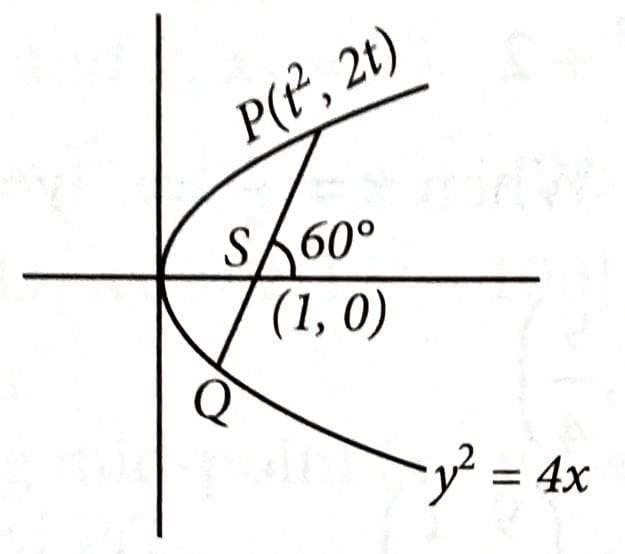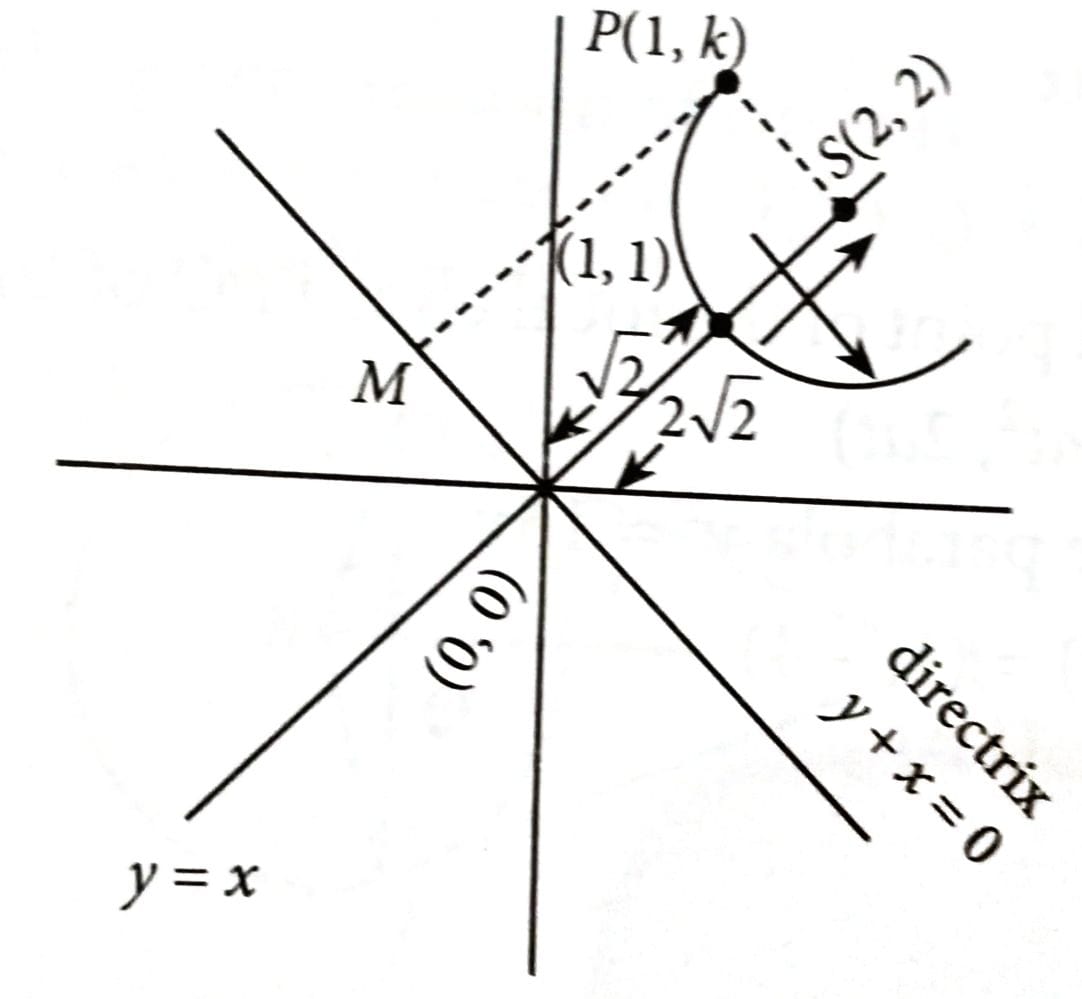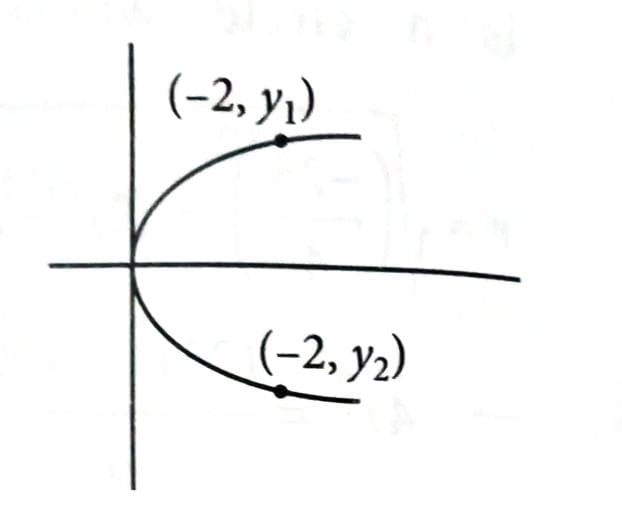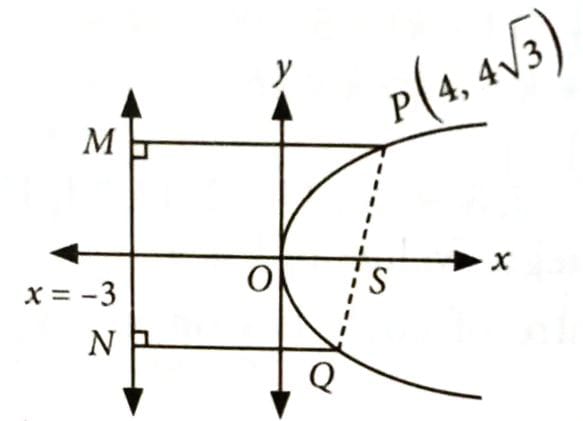Topic Question Set
Q 11
:
Let the line pass through the point of the intersection P (in the first quadrant) of the circle and the parabola . Let the line L touch two circles and of equal radius . If the centres and of the circle and lie on the y-axis, then the square of the areas of the triangle is equal to __________. [2024]
(72)
We have,
... (i)
... (ii)
Equation (i) and (ii) intersect at in first quadrant.
Radius of Circle and
We centre & of two circle are and respectively.
We know that length of perpendicular from centre to the tangent = Radius of circle
Centre of and are and respectively.
units, Height of triangle units
A = Area of triangle
.
Q 12
:
Let be a point on the parabola . If P also lies on the chord of the parabola whose mid point is , then is equal to __________. [2024]
(192)
We
Now, equation of chord of the parabola , bisected at is
Now, satisfies the above equation
... (i)
Now,
(Using (i))
.
Q 13
:
Let the focal chord PQ of the parabola make an angle of 60° with the positive x-axis, where P lies in the first quadrant. If the circle, whose one diameter is PS, S being the focus of the parabola, touches the y-axis at the point (0, ), then is equal to : [2025]
15
25
20
30
(1)
Let the coordinate of a point P be

Coordinate of focus S of the parabola is (1, 0).
Now,
{ P lies in first quadreant}
Equation of circle is
At x = 0,
.
Q 14
:
Let the point P of the focal chord PQ of the parabola be (1, –4). If the focus of the parabola divides the chord PQ in the ratio m : n, gcd (m, n) = 1, then is equal to : [2025]
10
17
26
37
(2)
End point of the focal chord PQ of the parabola is
Now, we have parabola
Point Q is given by
Now, focus of parabola is (4, 0)
Focus (4, 0) divides P(1, –4) and Q(16, 16) in ratio m : n
[ gcd(m, n) = 1]
.
Q 15
:
The radius of the smallest circle which touches the parabolas and is [2025]
(4)
The given parabolas are symmetric about the line y = x.

Tangents at A and B must be parallel to line y = x, so slope of the tangents = 1, which is minimum.
For point B,
When
Similarly, point
Radius = .
Q 16
:
The axis of a parabola is the line y = x and its vertex and focus are in the first quadrant at distances and units from the origin, respectively. If the point (1, k) lies on the parabola, then a possible value of k is : [2025]
8
4
3
9
(4)
For the parabola, axis is y = x
Directrix is x + y = 0

Also, vertex and focus are of and from origin
Vertex is (1, 1) and focus = (2, 2)
The point P(1, k) lies on parabola.
Using definition of parabola
PS = PM
k = 9 and k = 1.
Q 17
:
Let P be the parabola, whose focus is (–2, 1) and directrix is 2x + y + 2 = 0. Then the sum of the ordinates of the points on P, whose abscissa is –2, is [2025]
(2)

Equation of parabola.
... (i)
Put x = –2, in equation (i),
The sum of ordinates, .
Q 18
:
Let the parabola , meet the coordinate axes at the points P, Q and R. If the circle C with centre at (–1, –1) passes through the points P, Q and R, then the area of PQR is : [2025]
7
4
6
5
(3)
Given, equation of parabola is and equation of circle with centre at (–1, –1) is
... (i)
Let P(, 0), Q(, 0) and R(0, –3) are the three points.
Now, circle passes through point R(0, –3)
Put y = 0 in equation (i), we get
Point are P(1, 0) and (–3, 0)
Q 19
:
Let be a point on the parabola and PQ be a focal chord of the parabola. If M and N are the foot of perpendiculars drawn from P and Q respectively on the directrix of the parabola, then the area of the quadrilateral PQMN is equal to : [2025]
(2)
Since, lies on
is equation of parabola

Let be
As PQ is focal chord
Area of trapezium PQNM
[by definition of parabola]
.
Q 20
:
If the line 3x – 2y + 12 = 0 intersects the parabola at the points A and B, then at the vertex of the parabola, the line segment AB subtends an angle equal to [2025]
(2)
Given, 3x – 2y + 12 = 0
Put value of 'y' in , we get
y = 3, 12
Let A(–2, 3) and B(4, 12)
Since, vertex of parabola is O(0, 0).
.

